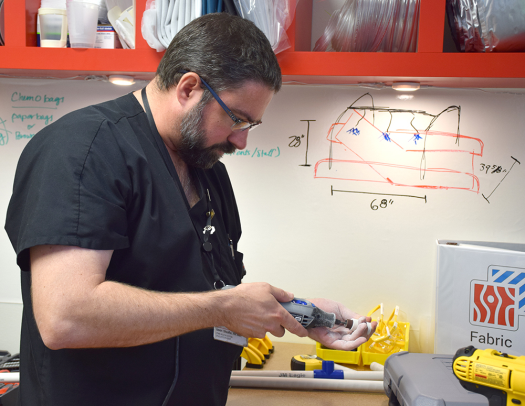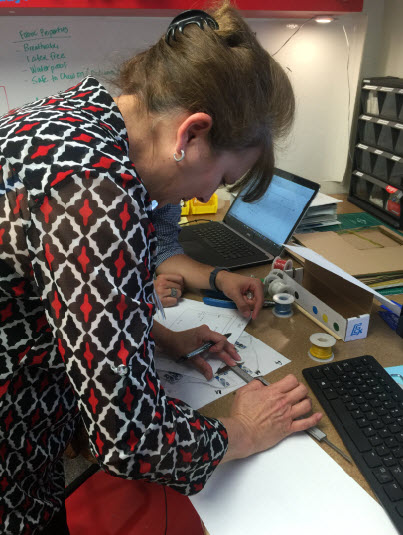
Blocker Burn Unit Nurse Manager Jason Sheaffer may not have a degree in engineering, but he has an idea for a device that could improve patient care.
“I’m working on creating a water delivery system to help nurses in the Burn Unit irrigate patient wounds more efficiently,” said Sheaffer. “Currently, we use a hose that requires a nurse to hold the nozzle the entire time, which can be several hours. I’m using PVC, a 3-D printer and other tools to model a system that would place several sprayers over a patient, essentially allowing for hands-free washing.”
Sheaffer is one of several nurses now using the Medical MakerHealth Space at UTMB—the first makerspace in the country for health care providers. It was recently launched by UTMB and MakerNurse, an initiative of the Little Devices Lab at the Massachusetts Institute of Technology, and is supported in part by the Robert Wood Johnson Foundation and a UTMB President’s Cabinet award.
Stocked with materials from Velcro and sewing needles, to 3-D printers and laser cutters, the makerspace empowers nurses and other medical staff to bring their ideas for improving health care to life.
UTMB’s Chief Nursing and Patient Care Services Officer David Marshall said the new medical makerspace will help bring nursing to the forefront of health care innovation.
“We know nurses have breakthrough ideas for improving health care. Providing them with the space, tools and materials to create these solutions, rather than outsourcing them to engineers and designers, just makes sense,” said Marshall.
Transforming ideas into reality
Nicole Wooten, an Emergency Services nurse clinician, created an arm-board device to assist during specialized cardiac catheterization surgeries. Cleo Glover, a nurse in Correctional Managed Care, made her own utility belt for carrying medications during patient rounds—she brought her prototype to the MIT site visit in 2014.
 Dell Roach, a nurse manager in Surgery and Cardiothoracic/Vascular Surgery, recently visited the lab for the first time to work on an idea she had after working in a pediatric cardiology environment.
Dell Roach, a nurse manager in Surgery and Cardiothoracic/Vascular Surgery, recently visited the lab for the first time to work on an idea she had after working in a pediatric cardiology environment.
“A lot of times, we have to cut adult-sized electrodes to fit children and then have to place them across their chest in specific locations and connect the 12 leads to the ECG machine,” said Roach. “That takes quite a bit of time and with small kids—squirming and crying and moving constantly—it’s hard to get it done. If we had a template based on their size that you could just place over their chest and then connect the wires, it would speed up the whole process.”
Nikolas Albarran, an engineer with MIT’s Little Devices Lab, assisted Roach in getting her prototype designed. He also demonstrated how to use some of the tools, so she could begin crafting a physical device with confidence.
“I think the lab is wonderful,” said Roach. “There are so many times we as nurses think about taking care of patients and say, ‘If only we had this, we could do it easier, faster, less painfully, etc.’ This is an opportunity to actually do it.”
Other nurses working on projects in the new space include Debra Flynn, a nurse clinician in the Labor and Delivery Unit, who has already developed two prototypes, including a device that can be used by obstetricians in the event of a prolapsed umbilical cord. Staff in the Pediatric Units also are looking at creating different IV covers that will protect a child’s skin while cushioning their arm and wicking away moisture.
All devices made in the makerspace are sterilized and tested through a quality improvement or institutional review board study before being used on the hospital floor.
The UTMB Medical MakerHealth Space is open to all UTMB medical staff and health professions students between 8 a.m. and 5 p.m., Monday through Friday in John Sealy Annex, Room 8.201.